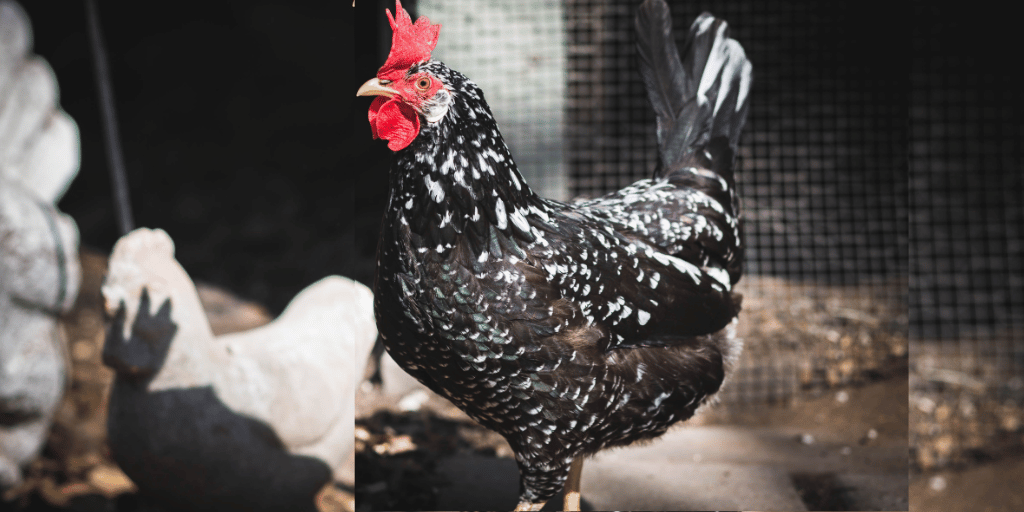Do you want to know about cool Ancona chickens? This guide will tell you all about them!
We’ll talk about their past, how they act, how long they live, what they do, how many eggs they lay, how big they get, and how to care for them.
These small chickens first came from Italy. Later, they got popular in England and America too.
Ancona chickens have black and white feathers. They lay lots of eggs – from 180 to 280 eggs per year!
This guide is great for chicken lovers and farmers. Keep reading to learn what makes Ancona chickens so cool.
History and Origin
The Ancona chicken is a special breed from Italy. It gets its name from the city of Ancona, which is in the middle of Italy.
Way back, the Ancona was the most popular chicken in Italy. No one knows for sure how it was first bred, but people brought it to England in 1851 and to the United States in 1888.
People in England and America really liked the Ancona chicken. It looks a bit like the Leghorn breed, but has different colors and patterns.
The Ancona chicken stands out with its black and white speckled feathers. Its white spots on black feathers and detailed designs make it look really cool.
Ancona chickens are tough and can live in different places. Because they came from mixing Leghorns and other breeds, Anconas are strong and can adapt well.
This makes Ancona chickens great for people who raise chickens at home or on small farms. Their hardiness and fun looks make them a popular pick.
Lifespan
Most Ancona chickens live around 8 years. But with good care, they can stay healthy longer. These tough birds do well when kept safe.
They are hardy and strong. But owners still need to check for lice and mites.
Color Varieties
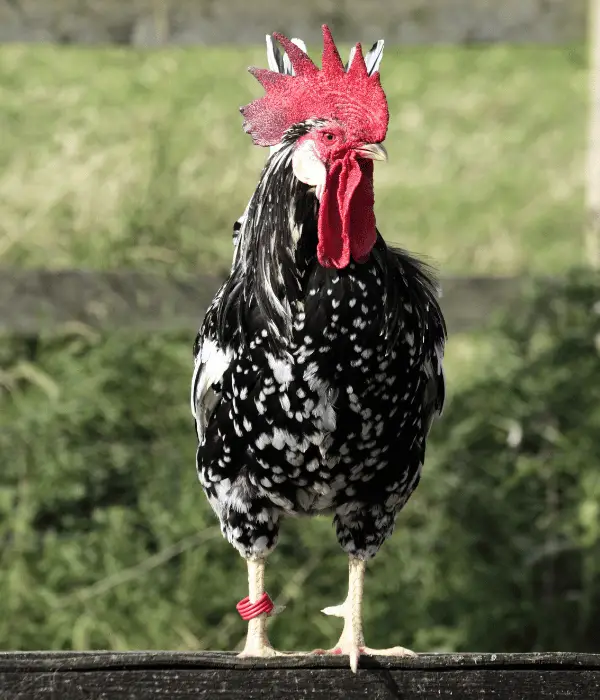
The Ancona chicken has an eye-catching look with black and white colors. Its feathers are a mix of dark and light shades, making it stand out from other birds.
These chickens have dark feathers with white spots or “spangles” all over. Breeders and farmers often choose black and white Ancona chickens because of their unique, speckled look.
Another type is the Blue Ancona chicken. Instead of black, its feathers are a bluish shade with the same white spangles. This blue color gives chicken lovers a different option for their flock.
Groups like the American Poultry Association (APA) recognize both the black and white Ancona, as well as the blue variety. These eye-catching birds add some color and fun to any chicken coop or backyard flock.
Temperament and Behavior
Ancona roosters and hens are active, curious, and intelligent. They are independent and adventurous.
These chickens are energetic foragers and enjoy exploring, so they need lots of space.
The Ancona roosters are protective of their flock and more robust. They can be territorial and aggressive toward other roosters, especially during mating season.
Their aggressiveness can be reduced with proper care and socialization.
However, hens are calmer and friendlier. They are good foragers and adapt well to free-range habitats. Anconas are mildly flighty but do not go away from their flocks.
Appearance
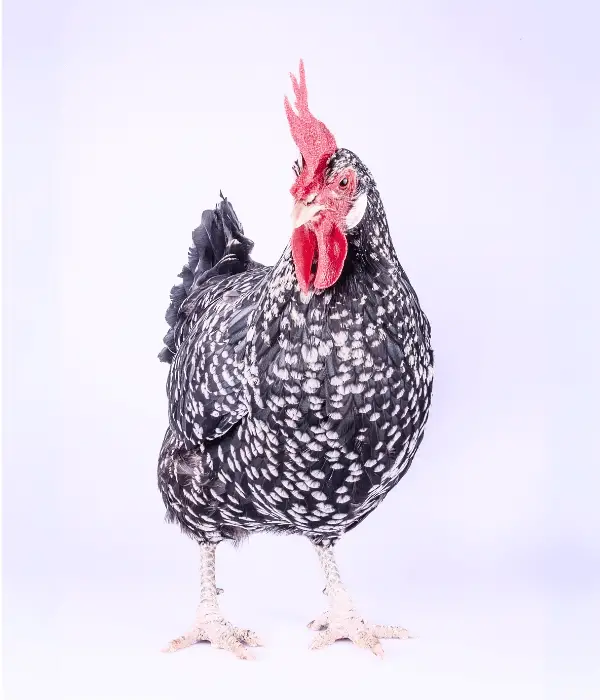
Ancona chickens have a striking look. They are medium-sized, yet seem very strong and sleek. Their skins are a bright yellow color.
These birds have shiny feathers that are spotted with black and white. The spots can be big or small. This pattern makes them stand out from other chickens.
On their heads, they have a single type, upright comb. The color of the comb is usually red or dark red.
Anconas also have red or dark red wattles. The wattles can be different sizes, but are usually medium-sized.
Their earlobes are smooth, round, and medium-sized, with a white color.
Ancona chickens have sturdy, yellow beaks in a pointed shape. This helps them easily peck at their food and hunt for bugs.
These birds have strong, yellow legs with three toes pointing forward and one pointing back. Most often, their toes are yellow or light gray.
Ancona Chicks Appearance
Ancona chicks look very cute. They have fluffy black feathers with white spots all over. This makes them easy to spot.
Their eyes are bright and lively. Ancona chicks love to explore new places. They like to move around and play with other chicks. It is fun to watch their curious actions.
Ancona Hen Egg Production and Broodiness
Ancona hens are great birds that give lots of eggs. They start laying eggs when they are just five or six months old.
Like Leghorn chickens, these hens lay big white eggs. Anconas can lay around 220 eggs each year.
These birds do not sit on their eggs to hatch chicks. This means they keep laying eggs steadily without breaks.
Small farmers and backyard chicken owners really like Anconas. Their eggs are top quality.
If you want baby Anconas, you’ll need a good incubator, since the hens won’t sit on the eggs.
Size and Meat Production
Ancona chickens are a medium-sized breed with a lovely shape. Adult hens weigh around 4.5 pounds (2 kg), and roosters weigh about 6 pounds (2.8 kg), similar to Leghorn chickens.
Bantam Anconas are smaller, with roosters weighing 20-24 ounces (570-680g) and hens weighing 18-22 ounces (510-620g).
While the taste and quality of Ancona chicken meat is not widely known, these birds are famous for their excellent egg-laying abilities. Many backyard chicken owners appreciate Anconas.
Best Tips For Raising Ancona Chickens
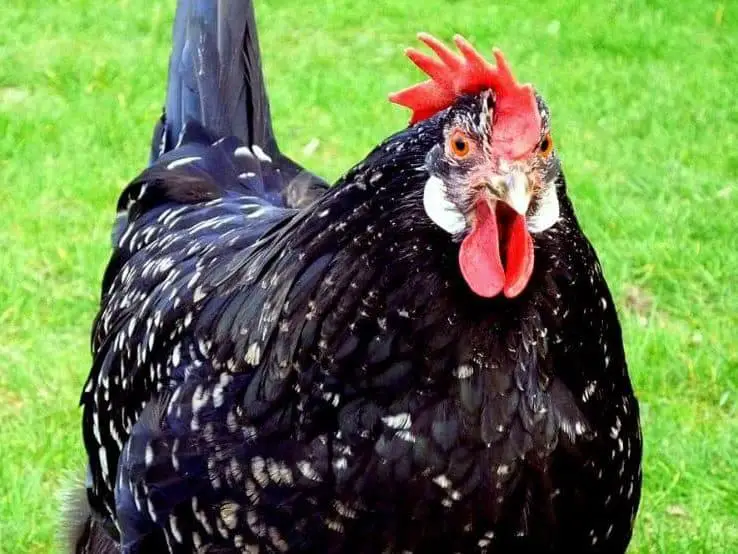
Below are a few common practices which you must follow when raising Ancona chickens:
1. Need Good Space: Ancona chickens need lots of space to move around. They must have a large chicken coop with comfy places to roost. The coop should be fenced to keep them safe from predators while allowing them to explore.
2. Balanced Diet and Nutrition: For good health and egg laying, give these chickens a balanced diet. Add fresh greens, grains, and treats to quality chicken feed. This provides all the nutrients they need.
3. Regular Veterinary Checkup: Have a vet check your flock regularly for health issues. Vaccines and proactive care help catch problems early. This keeps the chickens healthy.
4. Collect Eggs Properly: Anconas lay lots of eggs, so gather them often. Frequent collection prevents cracking and broody behavior, ensuring steady egg production.
5. Needs Comfortable Nesting Boxes: Set up cozy nesting boxes for these non-broody chickens. Well-placed boxes encourage natural laying habits and steady egg cycles.
6. Periodic Checkup For Internal and External Parasites: Check often for parasites like mites and lice. Provide dust baths. Clean the coop routinely. Preventing parasites keeps Anconas clean and healthy.
7. Need Socialization: Talk and play with your Anconas and watch how they act. Getting close helps find issues early. A friendly flock is calmer and easier to work with.
8. Maintain Proper Ventilation: Make sure the coop has good airflow. Fresh air prevents breathing troubles, ammonia buildup. Proper ventilation keeps Ancona chickens healthy.
9. Appropriate Lighting: Give enough light, especially when days are short. Good lighting helps egg laying, natural habits. Use sun or lamps as needed.
Common Health Issues in Ancona Chickens
Here are a few common health issues in Ancona chickens:
Ancona chickens can get sick with lung problems, coccidiosis, and Marek’s disease like other birds. These health issues affect their breathing and health.
The hens don’t get broody often. So, if you want to breed them, it’s hard. They don’t sit on eggs much, so you need an incubator to hatch their eggs.
Mites, lice, fleas, and worms can infest and live on Ancona hens. To prevent and control these pests, you must check and treat the birds regularly.
Poor diet can cause problems with Ancona bird growth, feather quality, and egg laying. Giving a balanced, nutritious diet keeps them healthy.
Like other chickens, Ancona hens can suffer heat stress in hot weather. Providing shade, good airflow, and fresh water prevents heat issues.
Owners should check their Ancona birds often, follow biosecurity, and get vet care when needed. Doing this helps the hens live long, healthy lives.
Where to Buy Ancona Chickens?
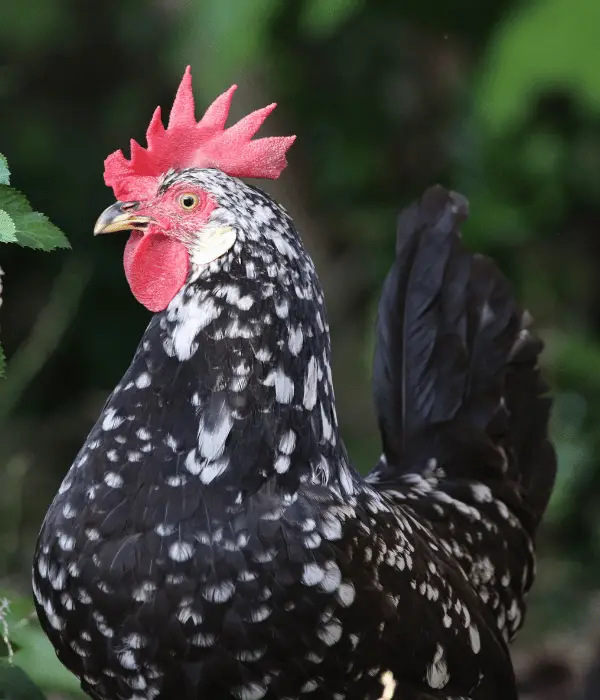
There are many choices if you wish to add Ancona chickens to your flock. You can buy them from local breeders, hatcheries, or order online from trustworthy sources.
When getting Ancona chickens, it’s vital to pick healthy birds without any diseases. They should be well-cared for too.
Several US hatcheries sell this chicken breed. Hovers Hatchery is one of the best for purchasing Ancona chicks.
They offer healthy, vaccinated chicks and have an excellent reputation for great customer service.
The Murray McMurray Hatchery is a famous hatchery operating over 100 years. They offer Ancona chickens among various breeds.
Meyer Hatchery is another option with a good reputation for buying chicks.
FAQs About Ancona Chickens
How Many Eggs Do Ancona Chickens Lay?
The Ancona chickens are prolific egg layers. Each year, they produce around 180 to 280 medium to large-sized eggs. These hens start laying eggs sooner than other breeds, often at just 5 months old. Their early maturity and high egg yield make them favored by many poultry farmers.
When Do Ancona Chickens Start Laying?
At around 16 to 20 weeks old, Ancona chickens will start laying eggs. Those chicks hatched early in the year may begin at 16 weeks. And they’ll keep laying steadily throughout the year.
Known for their productivity, Ancona chickens are reliable and prolific layers. They can lay from 180 to 280 medium-to-large white eggs every year. Plus, they tend to start laying sooner than many other breeds.
What Do Ancona Chickens Look Like?
These birds have black mottled feathers with white spots all over. Their bodies are slim and tall, with long legs. They have bright red combs and wattles on their heads. The white marks on black make an uneven pattern.
How Long Do Ancona Chickens Live?
Ancona hens can live for eight years if given vaccines. But, their life span depends on food, illness, predator attack, and breed type.
Like a strong coop, good food with water and a safe home helps chickens live long. They tend to be healthy if you give vaccines.
Summary
Ancona chickens are lovely and productive birds. They could be great for your backyard flock.
These chickens are tough. They can live in many environments and climates. Ancona flocks are friendly, too.
They are active. So, they are good pets for families with kids or other animals.
But, you must be careful with Ancona chickens. They are known for flying well. So, you need to keep them safe.
Moreover, Ancona chickens need good care to thrive. You must spend time and resources on caring for them.
If you want fresh eggs and beautiful backyard chickens, Ancona chickens may be perfect for you.
